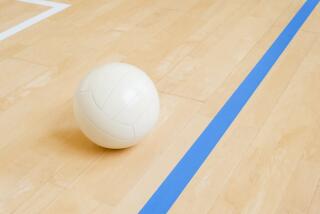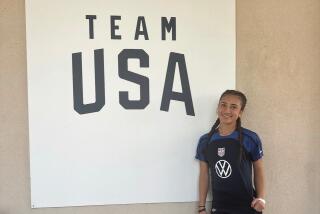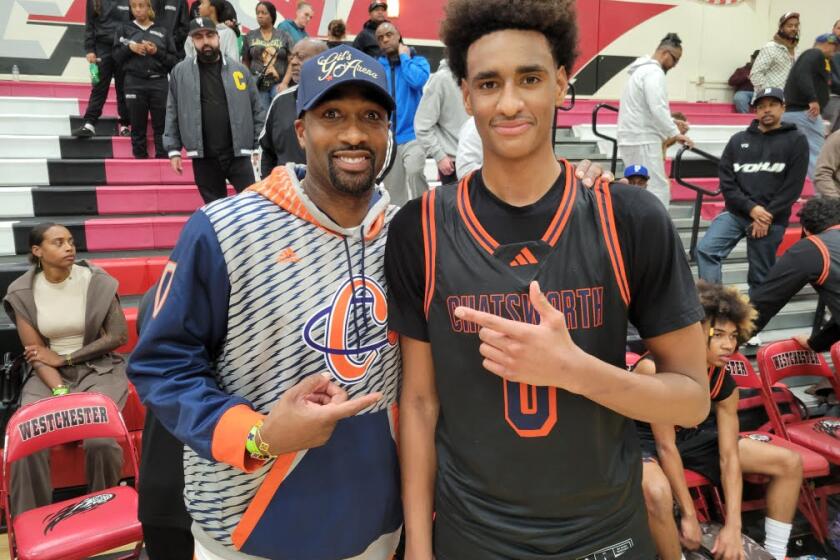No Play Like Home for Some Athletes
Gary Sacks’ coronation as the Southern Section singles champion last June seemed, at the time, nothing more than a notable moment marking the halfway point of an illustrious high school tennis career.
Turns out it was the last chapter.
The title set into motion a whirlwind summer of national junior tournaments for the confident 17-year-old.
Sacks returned to Calabasas in September, but the tennis trips didn’t cease. One weekend in New York turned into another in Hawaii, followed by a 2 1/2-week mid-March invitation to Brazil for an international tournament.
The level of competition improved for Sacks, and so did he. But back at Calabasas, the homework piled up along with missed school days.
On the road, many of his opponents seemed completely at ease with their work loads. Once Sacks found out why, he knew a change was in order.
By late fall, Sacks dropped out as a full-time student, thus ending his repeat title run before it started.
Sacks didn’t turn pro. He turned home. In January, he began an independent-study program that afforded him the ability to compete at a high level in tennis and complete his schoolwork without daily deadlines.
“Everyone was doing it and they were improving in tennis,” said Sacks, who ended last season ranked No. 1 in the U.S. Tennis Assn.’s Boys’ 16 age group. “I would have preferred to stay in school but that wasn’t really a choice.”
An increasing number of high school athletes have joined Sacks in opting for a home-based education. A sizable contingent continue to participate in California Interscholastic Federation sports, though some of the more gifted players move on to other endeavors.
Two of this season’s top basketball talents, junior Erika Arriaran of Norco and Tennessee-bound Sade Wiley-Gatewood of Lynwood, have had home-based educations at one point during high school. One of the top young water polo players, El Segundo freshman Coral Kemp, enrolled in an independent-study program from sixth through eighth grade.
According to the National Home Education Research Institute, the number of national high school students who are being home-schooled is growing at a rate of between 7% and 15% a year, now totaling more than 2% of the student population.
Research showed that during the 2000-2001 school year, anywhere from 1.5 million to 1.9 million children in the United States (grades K through 12) were home-educated.
Athletic commitments are one of several forces that pull students away from full-time enrollment. Parents, unhappy with a school’s environment, curriculum or core values, may choose to provide their children a home-based education. Families also use this option for children with exceptional gifts -- academic, artistic or athletic -- as well as those with particular learning needs or disabilities.
The home-based education trend is especially notable in tennis, where demands on players continually increase. Some feel they’ve outgrown high school competition. Others want the freedom to concentrate on training to turn pro while still maintaining the option to qualify for college.
“Everyone has a dream to play pro at a young age,” said Brad Dancer, Fresno State men’s tennis coach. “They are willing to sacrifice a normal high school experience.”
The exact percentage of Southland tennis players who have a home-based education is debatable. Sacks estimates that of the top 200 junior players nationally, about half aren’t enrolled full-time at their high schools.
Seena Hamilton, founder and promoter of the USTA’s Easter Bowl National Championship and one of the more influential voices in junior tennis, calculated that at her April 2003 tournament, 18% of the players -- and about half of the ranked players -- didn’t attend high school on a full-time basis.
“With what’s demanded of top players these days, they can’t keep up with school,” Hamilton said. “Kids love high school tennis, but it gets sacrificed as they get more competitive.”
Dominating the local tennis circuit is no longer enough. Hamilton said the USTA, in determining individual rankings, uses a point system that puts an emphasis on quantity of tournaments as well as overseas competition, which practically compels players to miss extensive periods of time during the academic year.
This spring, Seena Hamilton & Associates conducted another preliminary survey of Easter Bowl entrants. The results showed that 82% of those polled said the USTA’s point system forced them to miss more school. An average player missed 22 days a year, with the most extreme cases reaching 70 days -- largely because of tennis obligations.
Of the 17% who said they are not missing more school, about one-fourth noted the flexibility of home-schooling as the reason.
Parents have emerged as the most passionate opponents of the USTA’s new system.
Hamilton’s survey shows that families spend an average of $27,000 a year on tennis-related expenses, largely because of travel costs. Hamilton said parents have made passionate pleas to their sectional USTA chapters, which have responded by offering to host more International Tournament Federation events to lessen travel costs.
Still, Hamilton said that doesn’t address the need to cut down on missed school time. Her answer: Hold fewer national tournaments, de-emphasize the need for international play and focus more on local events.
“It’s up to individual coaches to start screaming out loud,” Hamilton said.
The Southern California USTA division voiced its discontent last April, when it became the only chapter out of 17 to vote against the current system.
Darren Potkey, director of junior competition for the Southern California division, said he is in favor of regional competition -- especially in the talent-rich Southland.
“Kids develop at a local level,” Potkey said. “There’s no reason for kids to travel across the country chasing points.”
For now, it appears home-based education is the best available remedy. The programs take on a variety of forms, including Sacks’ independent-study program that is run through an accredited high school in his home district. Sacks is assigned an academic advisor from the district who dispenses homework, grades assignments and meets weekly to discuss his pupil’s performance.
Sacks said taking national online courses is another popular choice for athletes on the road. Programs such as the California Virtual Academies run through charter schools allows students to receive and submit work through personal computers.
Students who are ahead of the normal learning curve can participate in early college matriculation programs during their junior or seniors years, allowing them to split class time between high school and local community colleges. Acceptance of home-based academics is now almost universal among universities. Fresno State’s Dancer said whether a recruit spent all four years as a full-time student on a high school campus is “not a factor” in his decision to offer a scholarship.
Arriaran, who returned to Norco for her junior year and will finish her senior season, is not worried that she will be penalized for her year away from school: “College coaches won’t care as long as I have my grades in order,” she said.
That hasn’t always been the case. Until the last few seasons, potential Division I and II athletes seeking to participate in sports and earn scholarships were forced to prove the merits of their home-based education programs by attaining a waiver from the NCAA. On April 1, home-based students officially became recognized as high school graduates and now need only to prove their programs are conducted in accordance with state law.
The issue is a little more complex in California, a state that does not recognize true home-schooling -- that is, parent provided or directed schooling outside the public school system -- or mention it in its law.
Recently, parents have had success proving their children’s academic setups are tied to accredited programs.
In the California Interscholastic Federation bylaws, students who are “not enrolled in programs under the jurisdiction of a member school’s governing body” -- which includes home-schooling -- are not eligible to participate in competition. The CIF rules allow participation from students who are affiliated with an accredited private or public school.
In states such as Illinois and New Jersey, however, home-schooled students are barred from participating in tournaments for individual rankings while participating in school athletics, Hamilton said.
The turn toward home-based education among local athletes has generated a growing dialogue regarding the use of such programs. Through her experiences as the youth and community director for the USTA’s Southern California branch, Annette Broersma has seen students thrive under home-based education.”I’ve seen it work for a lot of athletes,” Broersma said. “If parents are sure that they have a top-drawer student, [these programs] work well. For independent thinkers, there’s no worry.”
But Broersma does worry that some parents think only of their children’s athletic futures.
“Some parents have the wrong reasons in mind,” she said. “They have to realize that a marginal student will fall way behind.”
Sacks, who hopes to attend USC next winter, said he has struggled to stay on top of his work and that it would probably take him at least a semester in college to adapt to the daily work routine.
That shouldn’t be a concern for the two top-seeded players in last month’s CIF boys’ singles division at the Ojai Valley Tennis Tournament.
A good portion of the entrants qualified for the tournament through a part-time affiliation with their high schools. But Santa Ana Mater Dei’s Kaes Van’t Hof and Santa Barbara’s Blake Muller have stuck it out as full-time students, largely because their coaches have given them breathing room.
Van’t Hof misses occasional practices and matches to play in junior tournaments. Muller does the same, especially when given the opportunity to play practice matches against Sacks. But neither miss extensive periods of school.
Broersma wishes high schools would learn the same lessons in flexibility, thus allowing top players the option to remain as a full-time students.
That’s a sentiment shared by Thousand Oaks Coach Dave Assorson, who has a history of keeping top players for four years.
This season, Assorson has one of the top players in the Southland, sophomore Sam Querrey, who already has won the Easter Bowl Boys’ 16 division and the CIF boys’ singles title at Ojai.
“If you are too rigid, [top players] will find a way to leave,” Assorson said. “I don’t see any reason to be that strict.”
North Hollywood Harvard-Westlake Coach Chris Simpson has found a different way to keep top players engaged in high school tennis -- emphasize the importance of the team.
“National rankings are important, but if you have a decent ranking and you’ve done well at your high school, you’ll get recruited,” Simpson said. “College coaches are looking for players who understand what teams need.”
Still, as long as athletic demands continue to increase, young athletes will continue to come and go from high school programs based on individual interests.
And home-based academic programs will continue to help athletes such as Sacks excel -- without losing peace of mind.
“It’s been the best choice for me,” Sacks said. “I don’t get as stressed out anymore.”
More to Read
Get our high school sports newsletter
Prep Rally is devoted to the SoCal high school sports experience, bringing you scores, stories and a behind-the-scenes look at what makes prep sports so popular.
You may occasionally receive promotional content from the Los Angeles Times.






